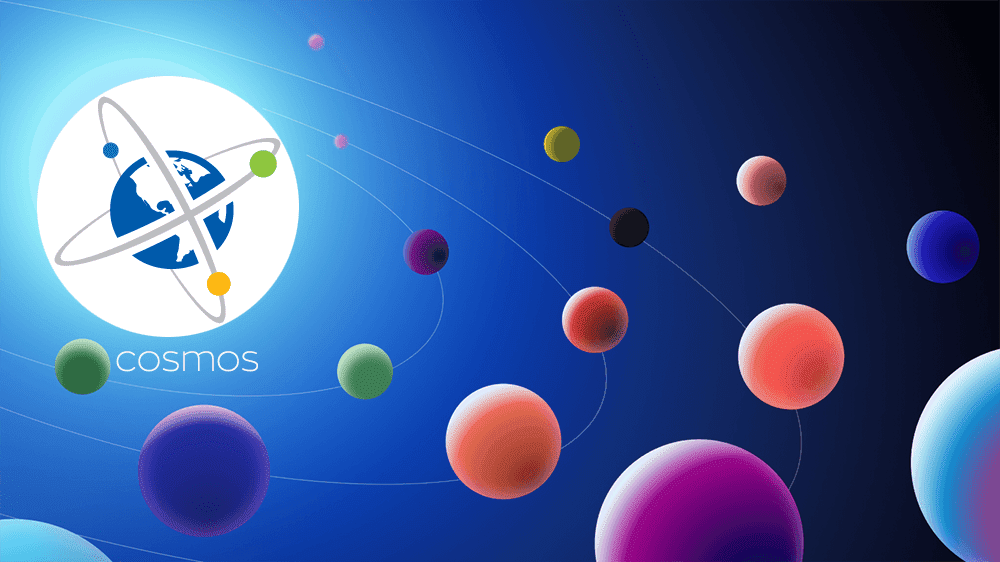The State of Cosmos
The State of Cosmos
Cosmos has positioned itself as the “Internet of blockchain”, thanks to an extensive ecosystem of interconnected applications and services. So far, the number of decentralized apps (dApps) and services on the platform has exceeded the 250th mark, and the volume of digital assets under management has surpassed $150 billion. The Cosmos Inter-Blockchain Communication protocol (IBC) allows its apps and services to connect seamlessly, allowing users to exchange assets and data across several decentralized blockchain networks freely.
Understanding Cosmos
As a layer 0 blockchain, Cosmos does the groundwork for layer 1 blockchains. Cosmos has a decentralized network of independent blockchains that are interoperable through the IBC protocol. For example, look at Binance Chain: Cosmos is the underlying blockchain over which the chain is built.
Any blockchain network built on Cosmos can interact with each other, allowing for cross-chain interoperability. The Tendermint Core consensus engine powers this. On the other hand, dApps are not deployed on the Cosmos network directly, but on the independent blockchains deployed on Cosmos – hence the term “application-specific blockchains”.
Also Check:
The State of Cosmos
Is a Multi-Chain Ecosystem the Future of Blockchain?
Top Blockchain Platforms of 2022
Today, the Cosmos ecosystem hosts many sovereign blockchain networks, all of which are scalable and can interact with each other – with notable ones being Binance Chain (BNB), Crypto.org (CRO), Terra (LUNA), and Cosmos Hub (ATOM). This has rightfully earned them the name “Internet of blockchains.”
Cosmos Software Development Kit (SDK)
This development kit helps users to build applications in three easy steps. The first step is to write your custom blockchain with a mix of prebuilt modules and custom modules. The next step involves testing your MVP with users, who will collect and iterate on feedback before you launch your app on the public mainnet. Finally, you can connect your app to other Cosmos blockchains, leveraging the core interconnectivity property of the network.
More than 35 wallets support the Cosmos Network and its tokens across various ecosystems. Some examples of hot wallets are AToken, Citadel One, Cosmostation, and more. Atomic Wallet and HyperPay are among some of the compatible iOS wallets. For Android users, there is Trust Wallet, Imtoken and a few others.
Kelpr Wallet
This is the most popular and the first-ever IBC-enabled Cosmos-focused wallet. It has amassed over 100k users, and its features include asset management, staking, rewards, dApps, governance, security and IBC transfers. The completely non-custodial Keplr wallet is available on both Android and iOS. Also, it supports the popular hardware wallet Ledger Nano S/X, which adds a further layer of security.
What Is The Usability Of Cosmos?
The usability of Cosmos is wide-ranging and diverse. Projects can leverage the network in ways more than one. For example, it can be used to expand the economy of one’s chain by connecting it to the Cosmos Hub Services through the IBC protocol. Developers can also use the protocol to earn support by bringing more users with services such as exchanges, wallets, etc. Individuals can also choose to become validators in the network, receiving rewards by securing the blockchain.
Latest Updates
Cosmos recently raised $150 million to assist early-stage blockchain interoperability projects. The funding comes after the Theta upgrade to the Cosmos Hub, the first of two major updates that will enable interchain accounts, which is a key component of Ignite’s (formerly Tendermint) vision for multichain interoperability.
Theta Upgrade
This represents the first major step toward interchain accounts by enabling the Cosmos Hub to act as a host chain. After the upgrade, other blockchains with interchain accounts enabled will be able to execute two major actions: create and control accounts on the Cosmos Hub, and perform Cosmos Hub native transactions.
Rho Upgrade
This will allow the Cosmos Hub to be a controller chain. When connected to other host chains, the Cosmos Hub would perform transactions natively on other chains. A good example is if another blockchain-enabled interchain account became a host chain, the Cosmos Hub community could vote to interact with that chain and perform a predefined set of transactions.
In the past, a community would have to elect a group to manage a multi-signature wallet and trust they would act fairly on the community’s behalf. Through batched messages sent using interchain accounts, transactions like swapping, staking, voting, and other types of action native to that chain would be executed directly by the community without ever needing to appoint and trust a third-party group. This allows the Cosmos Hub community to act in a completely decentralized fashion. The Rho upgrade will also feature Groups, which, together with interchain accounts, allow DAOs to interact with other natively-enabled chains. With Groups, DAOs who manage funds across multiple blockchains will be able to do so while only having to interface with the Cosmos Hub.


We welcome relevant and respectful comments. Off-topic comments and spamming links may be removed.
Please read our Comment Policy before commenting.